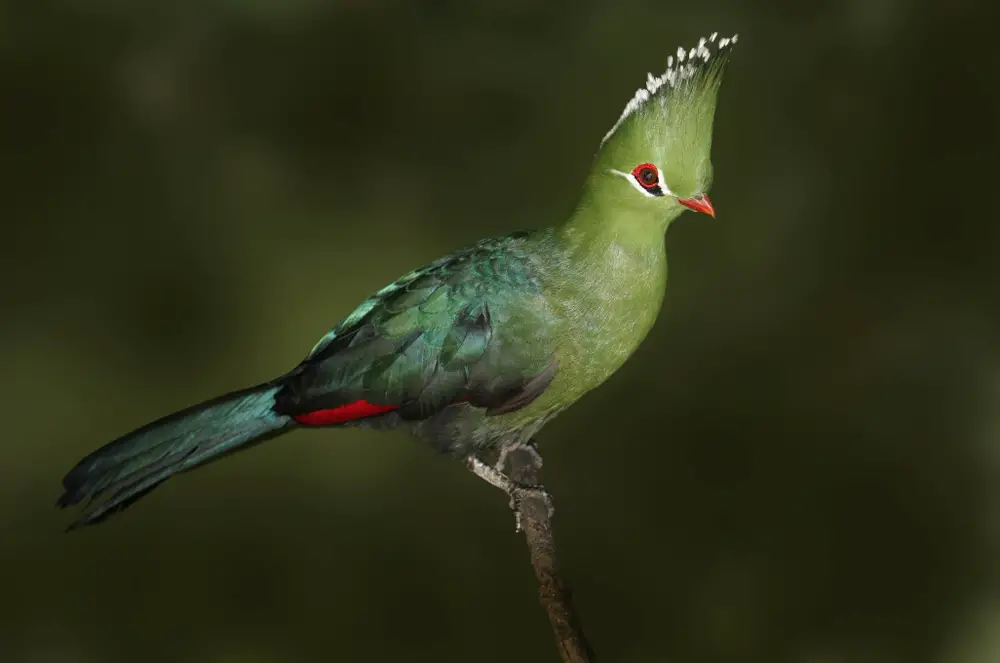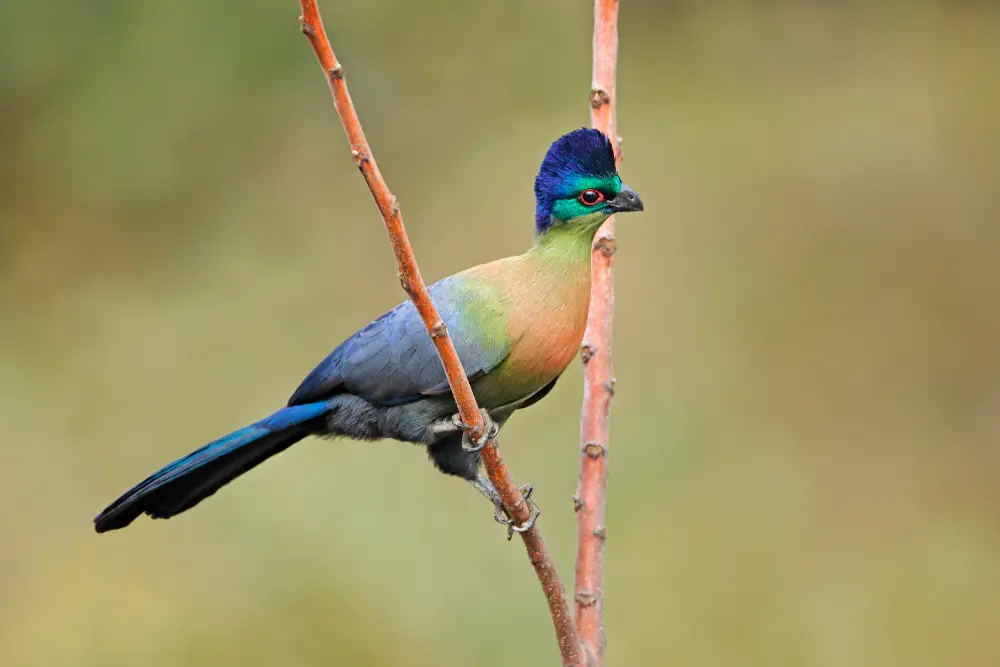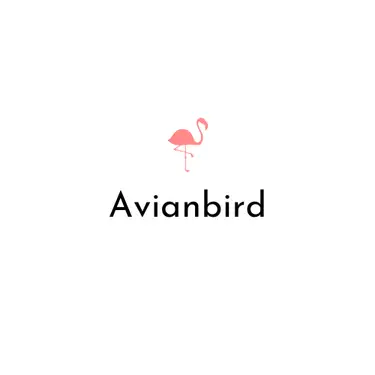Turacos are a group of birds native to sub-Saharan Africa and Madagascar. These colorful avian creatures have become increasingly popular in recent years due to their vibrant plumage and distinct behavior. This article provides an overview of the various species of turaco, including descriptions of their physical characteristics, behaviors, habitats, and conservation status.
The Turaco family contains four genera: Musophagidae (musophagids), Tauraco (tauracos), Corythaeola (corythaolas) and Perrinus (perrins). The most common genus is Musophagidae which includes 23 different species ranging in size from 8 inches to 28 inches long.
The tauracos contain 9 species while the corythaolas consist of 5 species; all of them inhabit tropical forests or woodlands across Sub-Saharan Africa as well as Madagascar. Many members of this family possess striking colors such as reds, blues, greens, yellows and oranges on their wings and tail feathers which give them remarkable beauty when seen up close in nature.
Behaviorally speaking, many turacos are active during daylight hours foraging for food among trees or branches but can also be found roosting at night in hollowed out tree trunks or caves where they remain safe from predators like owls or falcons.
They typically form large flocks composed mostly of females who feed together daily until sundown when they will return to their respective roost sites. Social bonds between individuals within these flocks are strong with males being particularly protective over female companions throughout breeding season especially against intruders attempting to steal eggs or chicks away from nests hidden among dense foliage high above ground level.

Definition
Turacos are a family of birds native to Africa, scientifically known as Musophagidae. A defining characteristic of turacos is their unique coloring pattern which includes areas of green, yellow, red and blue feathers. The members of this bird family can vary in size from the small Go-away Bird to the large Great Blue Turaco. They often have crest feathers on the head which gives them an even more distinguishable look.
The diet of turacos consists mainly of fruits, leaves, buds and flowers supplemented by some insects and spiders. Their preferred habitat is typically forested or woodland areas with trees that provide both food source and protection from predators. Though they usually nest in tree cavities, they may also construct nests on branches if there are no suitable tree hollows available.
Their behavior varies depending on the species; some spend most of their time in pairs or groups while others prefer being solitary feeders during daylight hours before coming together at night for roosting purposes. Despite their distinct appearance and habits, they remain relatively unknown due to their limited range throughout various parts of sub-Saharan Africa.
Physical Characteristics
Turacos are medium-sized, brightly colored birds. They have a distinctive shape with a long tail and short wings. Their bills are also quite large for their size.
The plumage of turacos is particularly eye-catching, with bright colors that range from blue to red in some species. The head may be patterned or solid in color, as well as the chest and back feathers.
Physical characteristics of turacos include:
- Bill size – These birds have larger bills than other bird species of similar size.
- Wing shape – Turacos possess short wings which give them greater maneuverability during flight compared to other avian species.
- Tail length – Long tails provide balance and stability while flying, along with aiding them when they need to escape predators quickly by providing strong propulsion through the air.
- Crest size – Most turaco species feature an impressive crest on top of their heads which can reach up to eight inches in length depending upon the specific type of bird being observed.
Overall, turacos display many unique physical features that make them easily identifiable among different types of birds found throughout the world today. From their colorful plumage to their large crests and bill sizes, these birds stand out amongst others due to their distinctiveness and beauty alike . They can also be identified by their unique vocalizations, which include a variety of loud, raspy calls.
Natural Habitat
Turaco are found in a wide variety of habitats throughout tropical Africa, ranging from dense woodlands and swamps to dry savannas. They inhabit lowland rainforests as well as mountainous regions at higher elevations. Turacos can often be seen perching on the branches of trees or hopping along the ground foraging for food. In areas with human activity, turacos may also use roadsides and gardens for feeding opportunities.
The majority of turaco species prefer forested habitats including wetlands, mangroves and swamp forests. Some species such as Tauraco porphyreolophus have adapted to living near humans and will feed in gardens, parks and even suburban streets. Turacos require large trees with thick foliage to provide cover while they sleep during the day or when it rains heavily.
Many turaco species are now endangered due to habitat destruction caused by deforestation and other activities that reduce their natural range. As a result, conservation efforts must focus on preserving existing natural habitats so that these beautiful creatures can thrive.
Diet And Feeding Habits
Turacos are predominantly fruit-eating birds, although they also consume insects, seeds and foliage. During the breeding season, turacos will supplement their diet with carrion. Turacos can be divided into two distinct groups based on dietary composition: frugivorous (fruit-eating) species and granivorous (seed-eating) species.
Frugivorous species mainly feed on fruits from trees or shrubs, but may also consume small amounts of leaves and flowers as well as some other items such as nectar and even sap. They usually forage in treetops or in low branches of dense vegetation where there is an abundant supply of ripe fruit.
The most important foods for these frugivorous species are figs and berries; however, other fruits such as bananas, mangoes and papayas can also form part of their diets. Insects are often consumed when ripe fruit is scarce or unavailable during certain times of year.
The granivorous species tend to concentrate more heavily on grains, particularly oats and millet which they glean from grassland areas near rivers. In addition to this grain source they may feed upon various types of seed including those found in wildflowers, weeds and vegetables growing nearby.
These granivores may occasionally take advantage of a wide range of insect prey if available including ants, beetles, caterpillars and termites among others.
Foliage should not be overlooked either since it can provide valuable nutrients that help meet the bird’s energy requirements while feeding its young amongst other things. Carrion is sometimes taken during the breeding period when food sources become limited due to seasonal changes or environmental conditions.
In summary, turacos have very varied diets depending on availability throughout different parts of the year which encompass a combination of both plant matter such as fruits and seeds along with insects and occasional carrion intake too.
This variation allows them to survive across a broad range of habitats providing suitable resources exist within each location enabling them to thrive despite challenging situations at times
Breeding Behavior
Turacos are unique in their breeding behavior which is characterized by a combination of courtship rituals and nesting habits. Courtship between turaco pairs typically involves aerial displays, calling out to each other and mutual preening. These behaviors help males and females form social bonds that can last for years before they commit to building nests together.
Nesting tends to involve both parents working cooperatively to build an open-cup nest using sticks and branches from nearby trees or plants. They line the inside with softer materials such as bark, leaves, grasses, mosses and feathers until there is enough depth for two or three eggs.
Turacos usually lay one clutch per year consisting of two or three white eggs that take around 24 days to hatch. The chicks are born altricial (helpless) so they rely heavily on their parents for food and protection while growing up.
Once hatched, it takes about 10 weeks before chicks fledge (leave the nest). During this time period adults provide consistent care including bringing back food and guarding them against predators like snakes or birds of prey. After leaving the nest, young turacos may remain close to home for several months before venturing further away from the parental territory.

Conservation Status
Turacos are a unique and elusive species of bird. Although they can be found in woodlands, savannahs, montane forests and wetlands across sub-Saharan Africa, the turaco population has been decreasing rapidly due to habitat destruction through deforestation and poaching for their feathers. As a result, these birds are now classified as an endangered species by the International Union for Conservation of Nature (IUCN).
In order to protect this vulnerable species, conservation efforts have been implemented around the world. Some of these measures include:
- Habitat Protection: This involves protecting existing habitats where turacos live while also creating new habitats that will serve as sanctuaries for the birds.
- Population Monitoring: Various surveys and studies have been conducted in order to monitor turaco populations and better understand their behavior in different areas. In addition, nests have been tagged to help track individuals over time.
- Wildlife Conservation: Organizations such as BirdLife International are working with local communities to raise awareness about wildlife conservation and develop strategies to ensure sustainable use of resources without jeopardizing ecosystems or endangering species like the turaco.
This multi-faceted approach is essential for protecting not only turacos but other threatened wildlife species as well. Through collaborative partnerships between governments, NGOs, scientists, and local communities we can work together towards conserving biodiversity across all continents.
Human Interaction
Turaco are highly social birds and require interaction with humans to be kept in captivity. Keeping turaco as pets requires significant effort, attention, and knowledge of their behavior and needs.
Petting a turaco can help create a strong bond between the owner and bird; however it is important to ensure that interactions between the two are non-intrusive and gentle. Turacos have been known to bite if they feel threatened or uncomfortable due to petting.
In addition to providing companionship for their owners, keeping turacos in captivity has also contributed significantly to aviculture studies. Turacos bred in captivity provide an opportunity for researchers to study the species’ behaviors, anatomy, genetics, diseases, reproductive physiology, diet requirements, nutrition needs, life expectancy, mortality rates and more.
Captive breeding programs typically involve hand-rearing young chicks by experienced handlers until they reach maturity at around one year age. This helps increase survival rate among captive populations while allowing researchers opportunities to observe development of turaco juvenile stages up close.
Studies conducted on captive turaco populations have provided valuable insight into various aspects of care needed for long-term health maintenance and prevention of disease outbreaks. Benefits gained from such research include improved diets tailored specifically for optimal growth and welfare of the birds which contributes greatly towards successful conservation efforts worldwide.
Conclusion
Turacos are an interesting species of bird, possessing distinct physical characteristics and natural habitats that make them unique. They have a varied diet consisting mainly of fruits and seeds, and display breeding behaviors similar to other birds in their family. Unfortunately, the conservation status for turacos is not good due to human activities such as logging and habitat destruction.
As humans continue to encroach on turaco’s habitat it becomes more important than ever to understand the impact we can have on these beautiful creatures. It has been demonstrated that when humans interact with wild animals in a positive way they are less likely to be aggressive or cause damage while looking for food sources.
Understanding this connection could help ensure that future generations will still get to experience the wonder of seeing these majestic birds take flight above the forest canopy.
Overall, turacos are an essential part of many ecosystems around the world and must be protected if their populations are going to remain healthy over time.
Research into their behavior, dietary needs, and interactions with humans should be conducted so that effective management plans can be put into place which protect both people and wildlife alike from negative outcomes associated with loss of habitat or food sources.
